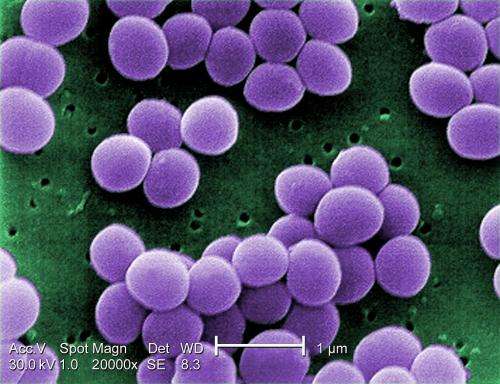Study reveals how bacterial pathogen adapts to nutritional stress

In order to cause disease, the human pathogen Staphylococcus aureus must adapt to the changing host environment. Many of these adaptations are mediated through two-component signal transduction systems (TCSs) that coordinate gene expression in response to environmental stimuli. In a new study reported in the Journal of Bacteriology, researchers at Illinois provide insight into the signal transduction mechanism utilized by the staphylococcal TCS ArlRS in response to host-imposed manganese and glucose starvation.
"Signal transduction systems, such as ArlRS, play critical roles in allowing pathogens to adapt to the ever-changing environment that pathogens encounter during infection and thus are critical contributors to disease," said Thomas Kehl-Fie (MMG), an associate professor of microbiology and leader of the study.
To limit S. aureus pathogenicity, the host sequesters essential nutrients—a process called nutritional immunity—such as manganese, zinc, and iron during infection. However, successful pathogens can circumvent this host defense and cause disease. The researchers zeroed in on one mechanism utilized by S. aureus to evade this host response that relies on the ArlRS two-component system, which comprises the histidine kinase ArlS and response regulator protein ArlR.
"We are particularly interested in elucidating how ArlR is activated, as this response regulator is implicated in the ability of S. aureus to both survive nutrient limitation and coordinate a response that attacks the host immune system," said Kehl-Fie.
"One of the interests of the Kehl-Fie lab is trying to understand how S. aureus resists nutritional immunity," said Paola Párraga Solórzano, Ph.D. student in the Kehl-Fie lab and first author of the paper. "Since ArlR was suggested to be activated by other histidine kinases, we wanted to understand if ArlS was necessary for the response of ArlR to manganese and glucose-limited conditions."
Although histidine kinases have specific interactions with their cognate response regulators, crosstalk can occur where histidine kinases can activate non-cognate response regulators. In other studies, a non-cognate histidine kinase was shown to activate ArlR, bringing the role of ArlS in resisting nutritional immunity into question.
To determine if ArlS is necessary for activation of ArlR, a mutant strain lacking the arlS gene was assessed for their ability to grow and activate ArlR in manganese-starved conditions. These conditions were achieved using calprotectin, an immune effector that sequesters manganese away from pathogens like S. aureus. The study revealed that ArlS is necessary for activation of ArlR under these conditions, said Párraga Solórzano.
Because glucose is the preferred carbon source for S. aureus, Párraga Solórzano evaluated the role of ArlS in glucose-starved conditions. While ArlR still had a level of activity in the absence of ArlS, ArlS was required for full activation in response to glucose limitation, said Párraga Solórzano.
"We were able to understand how these signaling mechanisms work and how S. aureus coordinates responses to stressful conditions normally encountered during infection," said Párraga Solórzano. "We determined that ArlS is important for the response of S. aureus to both manganese starvation and glucose limitation."
Preliminary studies that furthered this work were conducted by co-author and former undergraduate student Angela Shupe.
More information: Paola K. Párraga Solórzano et al, The Sensor Histidine Kinase ArlS Is Necessary for Staphylococcus aureus To Activate ArlR in Response to Nutrient Availability, Journal of Bacteriology (2021). DOI: 10.1128/JB.00422-21
Journal information: Journal of Bacteriology
Provided by University of Illinois at Urbana-Champaign




















